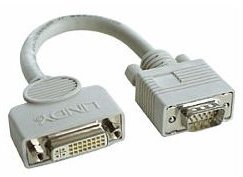Pros and Cons of Using a DVI to VGA Adapter
PC Video and Monitors
Whenever you start upgrading computer and electronic components, you will inevitably need to buy new cabling or adapters for your new gear. A good example of this would be when you upgrade the video card in your computer, then realize that your ‘old’ monitor doesn’t have the right connections to work with the new card. This means you will need to buy either an adapter or a new monitor. In this article, I’ll look into the pros and cons of using a DVI to VGA adapter.
Why Use a DVI to VGA Adapter?
Most new video cards these days come with DVI outputs on them. Likewise, most new monitors also support DVI connections. Many monitors support both VGA and DVI, while some older models only support VGA. If you were to add a video card to your computer that only did DVI output and your monitor only supported VGA, then you would need to get a DVI to VGA adapter in order to use your monitor with the video card. Luckily, most video cards include an adapter, or else you can buy one for just a few dollars.
DVI to VGA Adapters come in a variety of sizes ranging from simple one-piece units to those with short cables in between for added flexibility. They also make models with varying male and female connectors to suit your needs, so check your cable ends before you order anything. I’ve made the mistake of mixing up the male and female ends and had to re-order the right one.
Pros and Cons
The benefit of using a DVI to VGA adapter is that you won’t have to buy a new monitor in order to use your new video card, but there is a trade-off. Because you are using the adapter, you are downgrading the DVI signal to make it work via VGA. This means you aren’t getting the best quality output from your new video card, which kind of defeats the purpose of upgrading in the first place. It all depends on what your personal preference is and if you’re happy with the end result, then you might be able to hold off on buying that new monitor for a while. If you’re upgrading your video card for gaming purposes, then you really need to splurge on a good monitor, too. Why use a DVI to VGA adapter to choke the potential of your new gaming card?
DVI vs. VGA

With DVI output, you are sending the digital video signal directly from the video card to the monitor. This results in much better image quality because there is no in-between image processing. VGA, on the other hand, is an analog signal that has to be converted and therefore some quality is lost. VGA is also much more susceptible to distortion from outside influences, like power cables.
Where you can really see the difference between DVI and VGA is at higher resolutions. In a lower resolution, such as 1024 x 768, you might not notice much of a difference at all. This would be just fine on a 15” or 17” monitor. However, if you were to hook up a 22” widescreen monitor with a resolution of 1680 x 1050, the difference is quite noticeable. On a VGA connection, that 22” monitor is going to look kind of fuzzy and text won’t be so sharp. On a DVI connection, everything appears much cleaner and is easier on the eyes.
